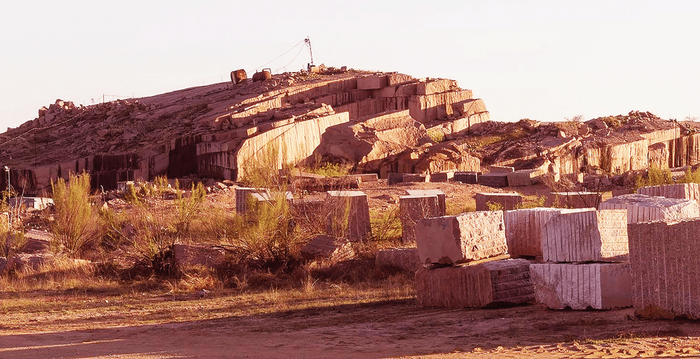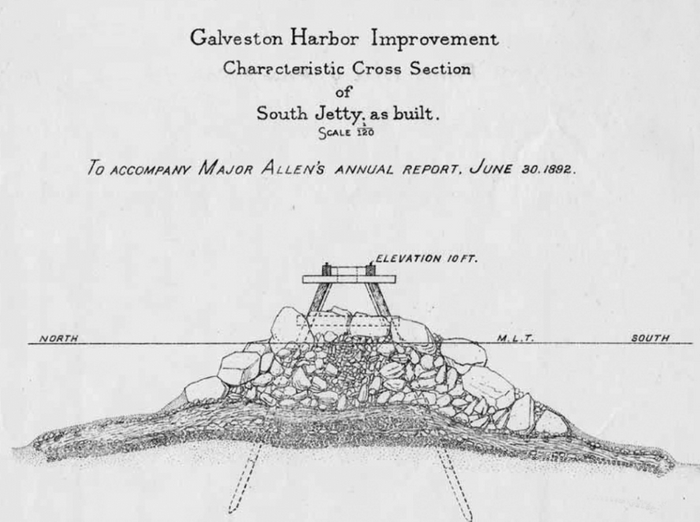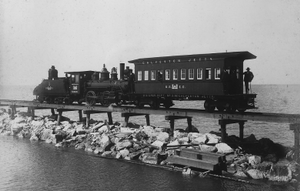The humble
granite block- it sits silently, faithfully serving this island city. For most
people these blocks are little more than convenient platforms extending into the
surf, places to enjoy the sights and sounds of crashing waves. They benefit
fishermen on sunny mornings and the aquatic sea life living in their crevasses.
They tend to blend into the scenery, and little thought is given to them.
The story of Galveston’s granite holds much more
significance than its silent presence indicates, but its place in island
history is usually overlooked. Etched in this seaside stone is the story of a
city's perseverance and the dreams of powerful men.
 It begins over 130 years ago, deep in the Texas hill country near a place now called Marble Falls.
It was here that a quarry was established to extract pink granite from a
200-foot-tall geological dome formation. This formation, the remains of ancient
volcanic activity, would be given the name Granite Mountain.
It begins over 130 years ago, deep in the Texas hill country near a place now called Marble Falls.
It was here that a quarry was established to extract pink granite from a
200-foot-tall geological dome formation. This formation, the remains of ancient
volcanic activity, would be given the name Granite Mountain.
In the
early years, the quarry brought in skilled stone cutters from Scotland, and teams of convict laborers, to mine
pink granite for the construction of the Texas
state capitol. But the same quarry a short time later would host another team
called the Galveston Company, arrived to mine stone for an amazingly large
project.
Their job was to cut tens of thousands of
giant blocks weighing between three and seven tons to build Galveston's north and south jetties. The south
jetty at the extreme east end of Galveston
Island would eventually be five miles
long, while the north jetty at the tip of Bolivar
Peninsula would extend an incredible six
and a half miles into the Gulf of Mexico.
 After the huge blocks were mined from Granite Mountain, they were loaded onto rail
cars and delivered to the coast. Rail trestles were built miles out over the
water where the stone blocks were carted and carefully placed into their
positions, creating the jetties. The Jetties are composed of a sandstone core
and covered by the giant granite blocks. Jetty construction was completed in
1898.
After the huge blocks were mined from Granite Mountain, they were loaded onto rail
cars and delivered to the coast. Rail trestles were built miles out over the
water where the stone blocks were carted and carefully placed into their
positions, creating the jetties. The Jetties are composed of a sandstone core
and covered by the giant granite blocks. Jetty construction was completed in
1898.
Political
Will And Money Come Together
The struggle to acquire these jetties was
long and uncertain but completely necessary for the city's economic survival. In
these early years, Galveston's
seaport was its beating heart. It was the driving force of the city's economy
as well as the city's very identity.
By the 1870s, this thriving seaport enabled Galveston to become one
of the wealthiest cities in the nation, per-capita. However, by the late 19th
century, it was clear that future success of this seaport was becoming
increasingly less certain.
The times were changing. The industrial age
had arrived, steamships were replacing sailing ships, and ships were getting
bigger. The introduction of larger vessels revealed an underlying problem,
quite literally - sandbars. Galveston
became increasingly reliant on lightering, the practice of anchoring a ship in
deeper water offshore and unloading the cargo into smaller vessels to get it to
the docks. Lightering is an expensive and inefficient process.
Subsequently,
competition grew among the nation’s seaports to attract the business of these
modern-era shipping lines, and soon, a rating standard was set into place. A
first-class rated seaport had a depth of 26 feet or deeper. A second-class
seaport had a depth of 20 to 25 feet, while a third-class port was less than 20
feet deep.
Galveston's
sandbars restricted the depth to a humbling eight feet of water at low tide. The
proud island city, with its wealth and opulence on full display, refused to be
humbled by lowly sandbars, and could not suffer the indignity of being labeled
a pathetic third-class seaport. Something had to be done.
This was the moment for leaders to lead. One
man stood up to the challenge, Colonel William L. Moody. This former civil war
officer who had made his fortune in cotton and banking would now lead a
committee of men which included some of the city's most successful and influential
residents. John and George Sealy, Harris Kempner, Colonel Walter Gresham, and
other members of the city's ruling elite were assembled to brainstorm the
problem. They met at the old Cotton
Exchange Building
and were titled the Deep Water Committee, or the DWC.
The sandbar problem was nothing new, and in
preceding years, other attempts had been made to combat the problem, from
driving pilings under water, to using gabions, which were large, submerged,
sand-filled baskets. These were feeble attempts and complete wastes of money.
The DWC knew that realistically, at least two
things would be needed to insure permanent deep water. First, they would need
stone jetties, and second, federal dollars to acquire them.
Soon, the DWC embarked on a political crusade
for deep water that in the end lasted more than ten years before it finally
succeeded. In the beginning, they were motivated by the recent success of New Orleans, which had
its own deep-water battle to conquer. The DWC set out to do exactly as New Orleans had done and
hired the same engineer.
First,
however, they would need the federal subsidies. In the 1880s it was not that
common for the federal Government to freely pass out millions of dollars. In
their quest, members of the DWC would spend years lobbying within Texas, as well as in
neighboring states, campaigning for congressional support for a deep-water
bill.
Colonel Gresham was sent to Washington, D.C.
to do the same. It was an uphill battle as other cities were competing for the
same money.
 The bill was so important to Galveston that eventually, members of the DWC
felt that in order to sway favor with a republican congress, they would need to
elect a republican to congress. This was pure politics.
The bill was so important to Galveston that eventually, members of the DWC
felt that in order to sway favor with a republican congress, they would need to
elect a republican to congress. This was pure politics.
The American Civil War was not that distant
in the past and these former Confederate army officers would ordinarily want
nothing to do with the hated Republican Party, the party of Lincoln. Eventually, they did succeed in
getting Republican R.B. Hawley elected to congress - the first Republican
elected south of the Mason-Dixon Line since
before the civil war.
In another reach for influence, a member of
the DWC had informed President Grover Cleveland of the excellent fishing in Galveston and invited him
to come down and enjoy the experience. In a stroke of good luck, Cleveland accepted the
invitation.
The Galveston Harbor Bill was finally passed
by the senate in 1890 and shortly after was signed by President Cleveland. With
this news the city burst into celebration. A holiday was announced, and
whistles were blown jubilantly throughout the city.
 Over the following years, thousands of
granite blocks were railed to the coast. By 1896 much of the Jetty project had
been completed and the mouth of Galveston
was dredged to measure between 27 and 40 feet deep.
Over the following years, thousands of
granite blocks were railed to the coast. By 1896 much of the Jetty project had
been completed and the mouth of Galveston
was dredged to measure between 27 and 40 feet deep.
That year, Galveston's Artillery Company gave a one-thousand
cannon salute on the beach to celebrate the arrival of world’s biggest cargo
ship, the Algoa. Shipping soon
doubled and in less than a year, Galveston had
become the world’s second biggest cotton port, second only to Liverpool, England.
Meanwhile back at Granite
Mountain, the quarry remained a busy
place as Galveston's
appetite for granite was not yet satiated. A few short years after the jetties
were completed, the 1900 Storm devastated the island, and the quarry once again
came to the city's aid as tons of crushed granite was needed for the aggregate
of the new concrete seawall.
As the 20th century progressed, Galveston was changing
more and more. The Port of Galveston no longer had the prominence that it had
held in the prior century, and it risked being overtaken by the Port of Houston.
Galveston
was now transforming into a tourism destination. With the addition of the
seawall, visitors were now coming to Galveston
to enjoy the beach, and this demographic was becoming a mainstay of the city's
economy.
 By the 1930s, it was becoming clear that the
city needed a way to preserve and even increase beach sand for the enjoyment of
the visitors. In the 1960s, granite blocks were once again brought in to create
small jetties along the seawall known as groins. The purpose of these was to preserve
beach sand and collect it from the flowing currents.
By the 1930s, it was becoming clear that the
city needed a way to preserve and even increase beach sand for the enjoyment of
the visitors. In the 1960s, granite blocks were once again brought in to create
small jetties along the seawall known as groins. The purpose of these was to preserve
beach sand and collect it from the flowing currents.
The groins have served their purpose
satisfactorily, and in addition, they have added an interesting and curious
aesthetic to the Galveston
beach-going experience.
The
efforts of William L. Moody and the Deep Water Committee have been both long-lasting
and far-reaching. After 130 years, it is apparent that the results of the Galveston
Deep Water Bill have greatly magnified to benefit the entire region,
particularly to Galveston's
old rival. The increased Gulf access has benefited the Port
of Houston greatly as it journeyed to
become one of the largest seaports in the nation and propelled Houston to becoming the fourth largest city in
the country.